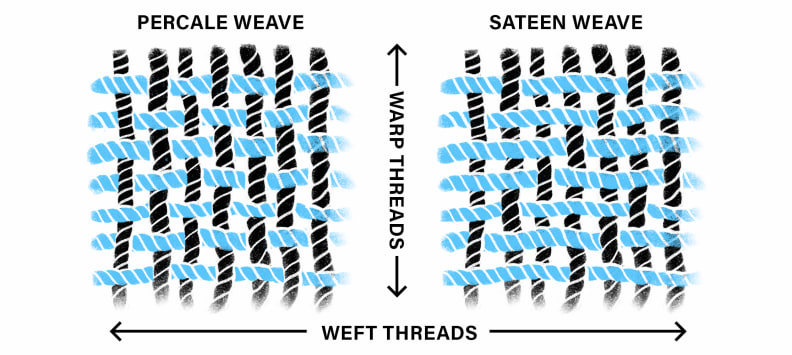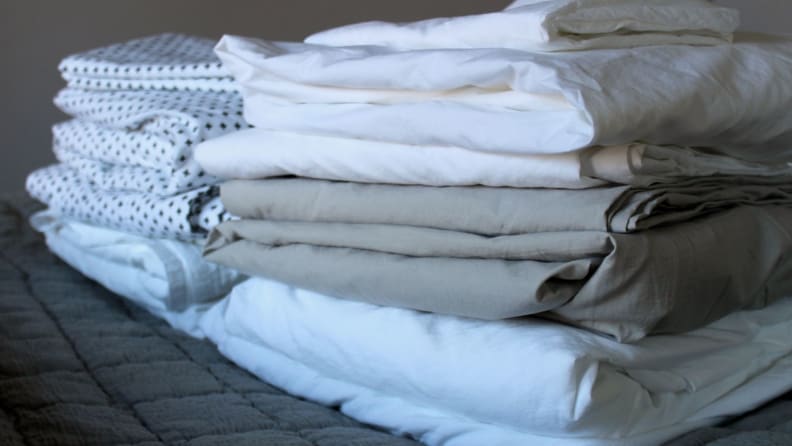Products are chosen independently by our editors. Purchases made through our links may earn us a commission.
It’s a common misconception that percale and sateen are different fabrics. They’re actually often made of the same material: cotton. Nonetheless, bed sheets made of each fabric have a unique feel as well as distinct benefits and drawbacks. And it all boils down to the weave, or how the threads are intertwined.
What is a fabric weave?

Percale and sateen fabrics are differentiated by the weave patterns—or how horizontal and vertical threads are intertwined.
Threads in woven fabrics are split into two categories depending on the direction they run in. Threads that run vertically, or from the top to the bottom of a piece of fabric, are called “warp” threads. Threads that run horizontally, or perpendicular to the warp threads, are called “weft” threads.
There are numerous types of weaves, but one of the main subgroups is called the “plain weave.” In this pattern, each thread passes over, then under, the perpendicular threads it intersects. Other weaves create different textures—and sometimes patterns—by skipping over threads, as opposed to following the strict over-one under-one pattern of plain weaves.
What is percale?

Percale has a grid-like fabric structure that makes the material crisp.
Percale is considered a plain weave. Imagine a simple over-under pattern used for basic baskets (or the strips of paper you wove together in elementary school). Though you can’t necessarily see the individual threads that come together to form a piece of fabric, they create a structure akin to a grid.
What is sateen?

Sateen fabrics have floater threads, which don't follow a strict 0ver-one under-one pattern.
Sateen weave relies on a perpendicular network of threads, like percale, but the way they’re woven together is totally different. Instead of following a one-to-one over-under pattern, sateen sheets have “floater threads,” according to Sean Cormier, an associate professor at the Fashion Institute of Technology (FIT) in New York City.
Floater threads run in the same perpendicular and parallel manner, but don’t weave over and under every thread they intersect. Instead, some threads pass over groups of other threads.
What are the benefits and drawbacks of percale?

Percale sheets have a reputation for sleeping cool.
If you’ve ever heard of percale, you likely know it has a cool and crisp sensation—though the sheets tend to get softer over time. It’s also considered one of the most breathable bedding fabrics out there. Percale weave tends to be tight, and some percale sheets are made with long staple cotton—think Egyptian or Pima. Staple length refers to how long a piece of cotton fiber is when it’s harvested.
It’s difficult to parse exactly what makes percale so airy—cotton is generally considered one of the most breathable fibers and the grid structure of percale could make it easier for air to flow through pores in the sheets. There doesn’t appear to be a consensus, but you can expect cotton percale to feel ultra-breathable even in hot summer months.
Percale bedding can also be more prone to wrinkling, especially if you purchase a higher thread count—any percale sets above 400 thread count may wrinkle more, according to Brooklinen.
Our favorite percale sheets are the Brooklinen Classic Core Sheet Set. The sheets have a crisp texture that’s great if you’re looking for that typical percale feel. Our tester loved how soft and smooth the sheets felt, and found the set’s high-quality stitching stood out.
What are the benefits and drawbacks of sateen?

The floater threads that differentiate sateen from other weaves can make the fabric more prone to snagging.
If you like the sensation of slick and silky fabrics, sateen may be a great choice for you. The fabric also drapes nicely over your bed during the day or your body at night. While it doesn’t affect functionality, sateen also has a slight sheen that some may prefer to the relatively matte finish of percale.
Sateen weave’s silky smooth structure can also make it more prone to snagging and, consequently, pilling. Things like jewelry (engagement rings, we’re looking at you) can be foes of sateen fabrics. The good news is that the weave is more wrinkle resistant.
If you’re looking for sateen sheets, we tested and loved the Brooklinen Luxe Core sheet set. It had a silky texture that our tester loved sleeping on every night. She found the sheets, though sateen, were cool and comfortable.
